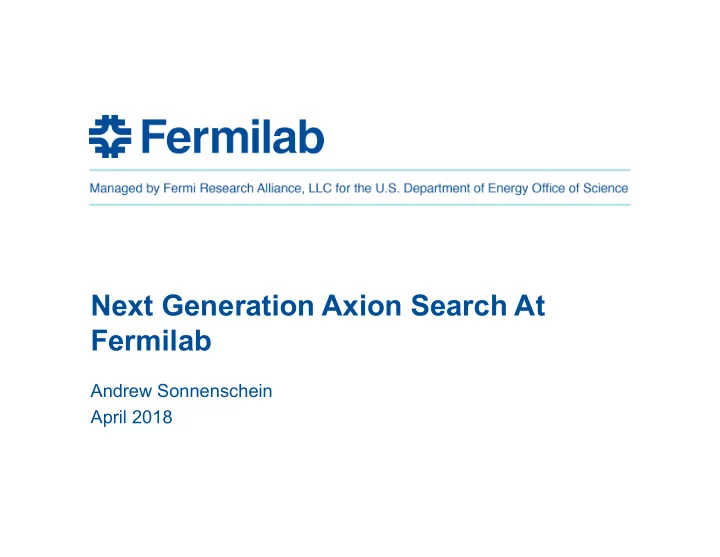

Next Generation Axion Search At Fermilab Andrew Sonnenschein April 2018
New ADMX Result • Leap in sensitivity due to reduced noise temperature. • Can now test DFSZ axion models over significant mass range. ArXiv 1804.05750 & PRL April 2018 2
Quantum-limited amplifiers MSA < 1 GHz > 1 GHz
Timeline For Current and Next Generation Experiment • ADMX- G2 Approved for operation through 2021 at University of Washington. • We hope to extend running at U Wash to 2024. • Next generation experiment could be located at Fermilab with construction starting as early as 2022. FY2018 2019 2020 2021 2022 2023 2024 2025 2026 2027 0.6-0.8 GHz Running Approved 0.8-1.5 GHz ADMX-G2 R&D Construction 1.5-2 GHz 2-2.5 GHz Extended ADMX-G2 2.5-3.5 GHz 3.5-4 GHz R&D Towards Next Generation Experiment: Magnet construction X Next Generation Experiment Quantum Sensors, Magnets, Resonators Run 4 Construction 4 GHz- 6 GHz Run 5 Construction 6 GHz - > 4
What Fermilab Brings to Axion Searches Scan Rate Vs Frequency & other parameters Higher Arrays of Quantum Magnetic Field Cryogenic RF Sensors Increases Resonators Reduce Noise Signal Increase (qubits, etc.) Volume 5
Quantum Sensors for Axion Detection • Aaron Chou leads effort to use qubits as single photon counters for microwaves. • Reduce noise levels below standard quantum limit. Potentially many orders of magnitude in power sensitivity. • New LDRD- funded facility in Lab B with large dilution refrigerator and 15- Tesla x 90 mm magnet. • Support from Heising- Simons foundation. • DOE Quantum Sensor initiative. 6
Fermilab 14- Cavity Array Concept for 2-4 GHz • Fermilab leads ADMX resonator design for 2-4 GHz range. • Requires complex mechanical assemblies at 100 mK with many moving parts. 1 K plate 1 K Vertical Cold Fingers 100 mK Plate 100 mK Vertical Cold Finger Layer 1: Piezoelectric Actuators Layer 1: 1K plate Layer 1: 100 mK Cavity Array k Layer 2
8
Concept for new ADMX magnet: 32 T, 16 cm Confidential FSU / NHMFL 32 T Field Winding Inner Radius 78 mm Winding Outer Radius 168 mm 172 mm High Field Length (B >82% B max ) Winding Length 513 mm Breakthrough 1: REBCO (rare-earth Ba 2 Cu 3 O 7 ) tape ultra-high field magnet • high critical field and • high mechanical strength Breakthrough 2: No electrical insulation on the conductor. • allows reduction of the amount of copper required for coil protection. • dramatically more compact coils and lower capital costs. 1 m NI-REBCO technology was pioneered by Seungyong Hahn, an associate professor at FSU and the MagLab. This design was generated by Denis Markiewicz who has developed dozens of world record superconducting magnets. Iain Dixon and Mark Bird (NMHFL) also involved. Assoc. Prof. Distinguished University Scholar Seungyong Hahn W. Denis Markiewicz Florida State Univ. Florida State Univ. 31July2 017 9
Why Propose this as “Flagship” for Cosmic Frontier? • Direct WIMP detection opportunities limited after conclusion of LZ & SuperCDMS. Axion searches are only now reaching interesting sensitivity and will remain scientifically relevant for many years– best opportunity to find DM in post-WIMP period? • Cosmic frontier at Fermilab suffers from lack of major experimental facilities on site. Axion searches could provide this. • Exploits major lab capabilities in cryo engineering, superconducting sensors, RF cavities and magnets. • Synergy with DOE quantum sensors program. • Fermilab is lead lab for current ADMX-G2 & best positioned of DOE labs for next generation experiment. 10
Recommend
More recommend